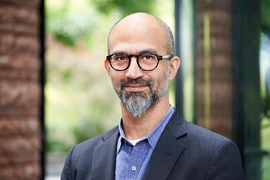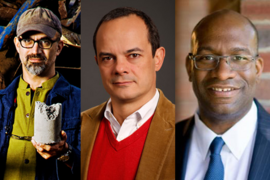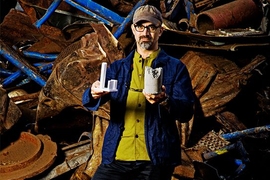John Fernández ’85 is not interested in overleaping boundaries so much as erasing them. The MIT professor, who was recently named director of the Environmental Solutions Initiative (ESI), started out as a child who loved math and art, and saw no reason to keep them separate.
“What brought me to MIT was my love of math. But I had always loved to draw, too, and I found sketching and the arts super interesting.”
The “happy medium,” as Fernández calls it, for a student like him was architecture and design — the subject he ended up studying, and later teaching, at MIT.
“I have always been most excited by creating an environment where there are no boundaries between disciplines,” he says. “In architecture, the most important boundary to dismiss is that boundary between design and technology or science. For me there is no boundary there. It’s all the same thing.”
Architecture is also what brought Fernández to the topic of sustainability. The period when he was studying architecture in school coincided with the rise of the green building movement. The United States Green Building Council had just been formed — the organization that would soon introduce the voluntary LEED (Leadership in Energy and Environmental Design) certification process, the most widely used third-party verification system for sustainable building in the world.
Today, this interest in sustainability and architecture has grown from a focus on buildings into an interest in the cities in which they’re housed. Fernández studies urban resource flows, also known as “urban metabolism.” Since starting the Urban Metabolism Group at MIT a decade ago, Fernández has conducted research in several cities across the globe, including Lima, Manila, Los Angeles, New York, Lisbon, and Boston.
This research on sustainability played a large part in Fernández’s selection in October 2015 as director of ESI, succeeding Susan Solomon, the Ellen Swallow Richards Professor in the Department of Earth, Atmospheric and Planetary Sciences, who served as the initiative’s founding director.
ESI’s focus is environmental and social sustainability at all scales, from campus-wide to worldwide. In a previous announcement of the new appointment, Solomon emphasized Fernández’s international research on urban sustainability as a major asset to ESI but explained that he also brings much more to the initiative. Fernández, she said, “has a deep understanding of MIT’s strengths across a very diverse suite of environmental challenges, and he brings a clear commitment to excellence and breadth.”
This breadth becomes clear when Fernández describes his vision for ESI. “There is enormous potential on campus to greatly expand in many different ways MIT’s engagement with the environment, both locally and regionally, but also to extend MIT’s role as a critical global player.”
According to Fernández, “research, education, and convening” are the pillars in ESI’s next phase as an organization. He’s looking forward to working with the MIT Energy Initiative, Office of Sustainability, Climate CoLab, Joint Program on the Science and Policy of Global Change, and others on campus engaged in solving challenges at the intersection of energy, environment, and climate change. Fernández knows that participating in “strong, deep, and sustained conversations” will continue to propel MIT forward as a leader in these areas.
On the research front, a key ESI activity is providing seed funding for highly multidisciplinary projects that can be difficult to fund through traditional channels. In fall 2015, ESI awarded nine seed grants for research focusing on topics including sustainable consumption in cities, safe mining on land and at sea, and mitigating global climate change. The initiative expects to launch another round of seed grants in fall 2016.
In terms of education, says Fernández, “We want to expand the undergraduate and graduate students’ exposure to environmental topics as part of their education, as part of the offerings that are available for their courses and their individual research.” ESI is now designing an environment and sustainability minor for undergraduates, in consultation with faculty and students across the Institute.
In Fernández’s view, MIT students are central to all ESI efforts. Part of the importance of focusing on students, he says, lies in engaging them to catalyze change. “We want to create a pathway from learning and research to action,” he explains. “Many of the most promising modes of action are student-driven.”
Measuring cities' sustainability
In Fernández’s own research on urban metabolism, the action that stems from the data is also important. Fernández and his fellow researchers are trying to “establish a typology, or classification, of urban resource consumption.” In Fernández’s words, “The idea is that all cities are different, but we wondered whether you could group cities in clusters depending on their urban resource consumption.” To bring this about, Fernández and his team ran a statistical study and developed a global urban resource consumption profile. This profile, in turn, informed a computational model that enables city leaders to visualize their cities’ resource needs and utilize materials and energy in the most efficient, sustainable way possible.
Research on this model is part of what has made Fernández’s travel destinations over the past decade so free-ranging: He aims to understand, and help others to understand, resource consumption on a global scale. The timescales he thinks in are similarly large. “One thought experiment we run is to imagine what pre-fossil-fuel-era cities’ resource intensity was,” he says. “If we want to have a post-fossil-fuel future, we can also look to the past for clues as to what that looks like.”
There is no one answer. Fernández is quick to point out that development needs vary greatly between what he refers to as “the global north and global south.” This means that the ideal definition of urban sustainability varies, too. “In the north, standout cities are those that have begun to shift their existing infrastructure toward decarbonization and deep resource efficiency, including better water management and waste management systems,” he says. “In the developing global south, model cities are those that are leapfrogging 20th century urban models to take advantage of renewable energies and decentralized and modular technologies and systems.”
On top of this, Fernández says, it’s important to remember that the most important measure of a city’s sustainability is how it treats its inhabitants. “Development and sustainability must be accomplished in a humane way,” he says. “The most resource-efficient cities on the planet — the ones that run themselves with the fewest resources — are also the least humane cities because they essentially underserve their populations. We need to couple sustainable development with lifting people to humane living standards.”
At home with students
On campus, director of ESI isn’t Fernández’s only new position. He was recently made head of Baker House, meaning that he acts as a faculty presence within that slice of the student community, albeit “one who is never going to grade you.” Fernández and his family live in an apartment attached to the dorm, and he holds weekly events with the students. “Being head of house means you’re someone students can bounce ideas off of and have an intellectual relationship with, but the evaluation piece goes away. That’s really nice, because that cuts through the anxiety and the stress.”
Being head of Baker also gives Fernández a chance to partner with interested students on small-scale sustainability projects. One example, he says, is a form of dorm-scale indoor farming. The incentive, he says, is not just to have herbs and vegetables at the ready for cooking, but also “for the mental health benefits of having plants around.”
The personal growth of students is important to Fernández for several reasons. What he finds most exciting about teaching, he says, is “the full cycle. Seeing students going from the classroom out into the world within just a couple years, practicing in their fields and in many cases becoming champions of a better world — that’s the most rewarding part of teaching.”
This article appears in the Spring 2016 issue of Energy Futures, the magazine of the MIT Energy Initiative.










